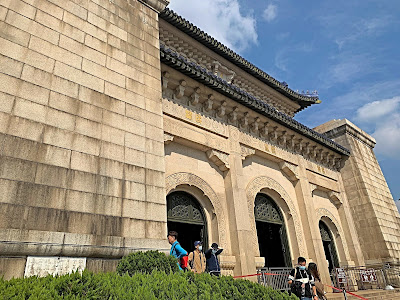After our surprised 2 km walk to this mausoleum, we needed FOOOOOOD! Luckily, there were some food shops. We chose to have a quick bite in this quaint little biscuit shop. Had Japanese curry rice for brunch.
Biscuit molds
This shop specialized in Jasmine biscuits
Pretty cafe
Xiao Jing Ding
"Xiaojing Tripod is 4.3 meters high and weighs 5 tons. Cast on its surface are 3 characters - wisdom, benevolence and bravery. It houses a hexagonal copper plate inscribed with Xiaojing transcribed by Lady Huang, mother of Dai Jitao, a senior statesman of Kuomintang. The tripod was produced by Jinling Arsenal in 1932."
I have no idea what this tripod is all about.
I read reviews about it and it is supposedly a filial piety tripod. Xiao means filial piety; respect for parents and ancestors. Some reviews stated that this tripod is also known as the Ding of Filial Piety or Yao Jingding.
A ding 鼎 is an ancient Chinese cauldron or vessel standing on 3 legs, used in rituals. I am guessing this particular ding was used for ritual offerings.
Nevertheless, this particular bronze Ding was donated by students from National Sun Yat Sen University and Dai Jitao (followers of Sun) to commemorate Dr. Sun Yat Sen.
Philanthropic Archway
The main entrance to the mausoleum is a 4-poster style 3-ancient archway. "Bo Ai" was inscribed on the transom which symbolized Dr. Sun's magnanimous heart and profound love.
A long walk from the arch to the first gate
Cute house on the side
Tri-Arched Marble Gate
陵门 Líng mén
I called this the First gate!
This is Half-Moon Square where a marble Memorial Archway stands. It has 3 archways, each of which has a copper gate. On both sides of the gate, pine, cypress and gingko trees guard the place.
"Tian Xia Wei Gong" was inscribed on the tansom, which means, "What is under heaven is for all"
Stele Pavilion
I called this the Second gate with a great stele in it.
100+ years Osmanthus trees
Stele Pavilion
碑亭 Bēi tíng
"The Stele Pavilion, 12 meters long at each bottom side and 17 meters high, is a granite construction roofed with blue-glazed tiles. The stele erected inside is 8.1 meters high and 4 meters wide, with a 3-line gold-plating inscription on it written in Yan Zhenqing style by Tan Yankai, one of the founders of Kuomintang, characterized by vigor and strength."
Sacrificial Hall
Finally.... the 392 steps leading to Dr. Sun Yat Sen's mausoleum. It is about 518 feet high.
View from the mausoleum
Sacrificial Hall
祭堂 Jì táng
This is Dr. Sun Yat Sen's mausoleum with a blend of Western and Chinese architecture. The 3-arched doors are inscribed with "Nationalism" 民族 , People's Rights 民权 and People's Livelihood 民生
Above the 3-arched doors, there is another inscription "Tian Di Zheng Qi" which means uprightness in heaven and earth.
Entrance to the mausoleum
Dr.Sun Yat Sen 孙中山 ( Sūnzhōngshān )
Father of the Nation
This mausoleum is the final resting place of one of the greatest leaders of modern China. Dr. Sun, a physician and political philosopher, played a crucial role in overthrowing the Qing Dynasty and ended the feudal monarchy in China. Dr. Sun was the first leader of the Kuomintang and the first president of the Republic of China.
"The construction of the Sacrificial Hall displays both the traditional Chinese style and the European style. On the door-head of the hall is inscribed with tiandi zhengqi (meaning "Righteousness of the World") written by Dr. Sun Yat Sen and minzu, minquan, minsheng (meaning "Nationalism, People's Rights and People's Livelihood)by Zhang Jingjiang, a senior Kuomintang official. At the center of the hall is a white marble statue of Dr. Sun Yat Sen carved by French sculptor Paul Randowsky while the eastern and western walls of the hall are inscribed with The Fundamentals for Establishment of the Nation drafted by Dr. Sun Yat Sen. The coffin chamber is centered by a lying statue of Dr. Sun by the Czech sculptor Gorch, under which Dr. Sun's remains in a copper coffin are buried deep."
Dr. Sun Yat Sen's Mausoleum
中山陵 Zhōng shānlíng
Sits at the foot of the 2nd peak of Purple Mountain. The tomb was constructed in 1926 and completed in 1929.














































































No comments:
Post a Comment